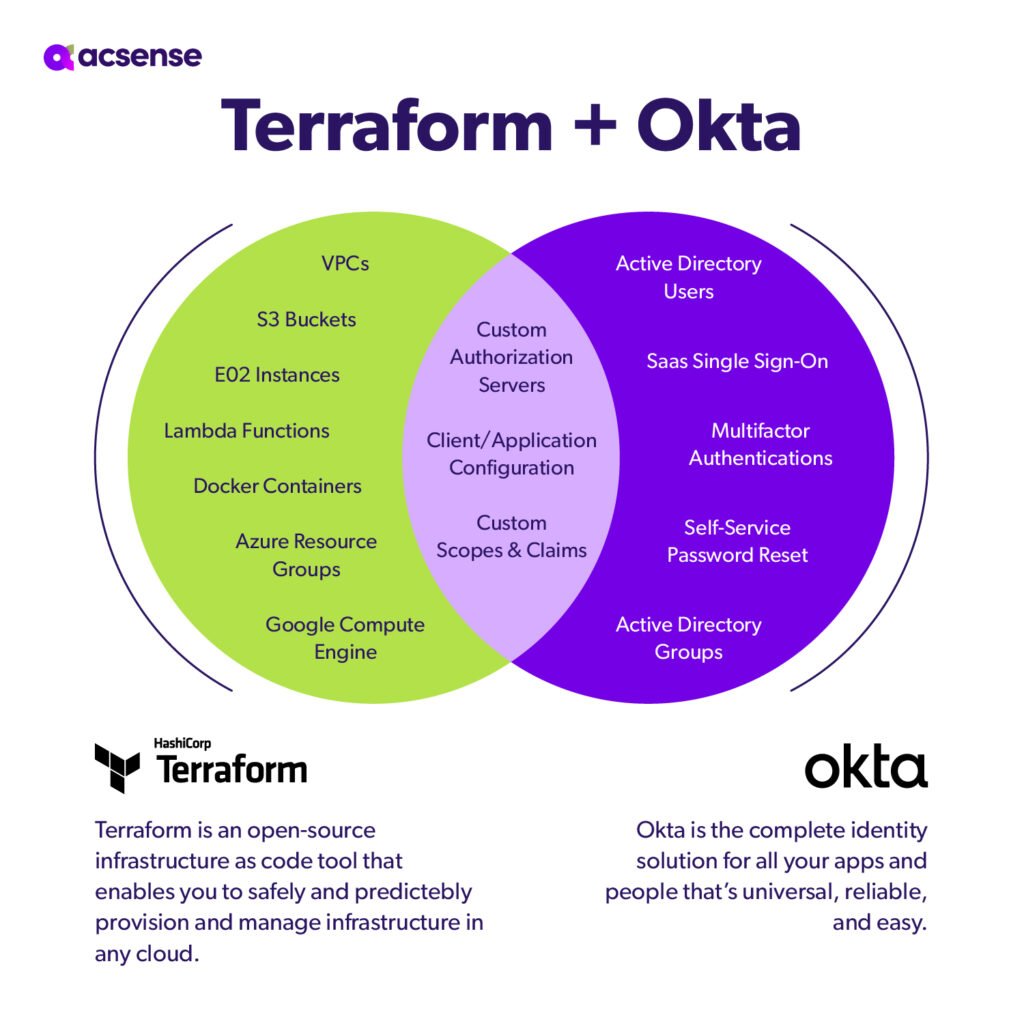What is Okta Terraform Provider?
Terraform is an infrastructure as code (IaC) tool that allows users to define and provision infrastructure resources using a declarative configuration language.
A key component of Terraform’s functionality is its providers, which are plugins that interface with various infrastructure platforms and services.
The Okta provider is one such plugin, specifically designed to interact with the Okta Identity and Access Management (IAM) platform. Okta is a popular cloud-based IAM solution that provides secure user authentication and single sign-on capabilities for enterprises.
With the Okta provider for Terraform, users can manage Okta resources, such as users, groups, applications, and policies, through code. This eliminates the need for manual configuration and allows for greater control, reproducibility, and scalability when managing Okta-related infrastructure.
The Okta provider integrates seamlessly with Terraform’s workflow, enabling users to define Okta resources within their Terraform configuration files. These configuration files can then be version-controlled, shared, and easily deployed, providing a consistent and automated approach to managing Okta resources.
By leveraging the Okta provider, organizations can employ infrastructure as code principles to manage their Okta IAM infrastructure alongside other infrastructure components, such as cloud resources and networking.
This allows for a unified and consistent approach to managing all aspects of their infrastructure.
How to Integrate Okta with Terraform?
Integrating Okta with Terraform is a straightforward process that involves a few simple steps.
Here’s a step-by-step guide on how to integrate Okta with Terraform:
- Install Terraform: First, make sure you have Terraform installed on your local machine. You can download and install Terraform from the official Terraform website (https://www.terraform.io/downloads.html). Follow the installation instructions specific to your operating system.
- Configure Okta provider: Once Terraform is installed, you need to configure the Okta provider. You can do this by adding a provider block to your Terraform configuration file (
main.tf). The provider block specifies the necessary configuration options for the Okta provider, such as the API token, Okta domain, and other authentication details. Here’s an example of how the provider block may look:
“`
provider “okta” {
api_token = “your-okta-api-token”
organization_url = “https://your-okta-domain.okta.com“
}
“`
Replace your-okta-api-token with your Okta API token and https://your-okta-domain.okta.com with your Okta domain URL.
- Define Okta resources: With the With the Okta API Token and Okta Domain URL are two key configuration options that you need to specify to integrate Okta with Terraform.
How to use Okta Provider in Terraform?
Once you have integrated Okta with Terraform by configuring the Okta provider, you can start using it to define Okta resources in your Terraform configuration files.
Here’s how to use the Okta provider in Terraform:
- Define Okta resources: In your Terraform configuration file (
main.tf), you can define Okta resources such as users, groups, applications, and more using the Okta provider’s resource blocks. These resource blocks specify the desired state of the Okta resource you want to manage.
For example, to create a new user in Okta, you can use the okta_user resource block and specify the necessary attributes like their email address, first name, and last name:
“`
resource “okta_user” “example_user” {
email = “[email protected]“
first_name = “John”
last_name = “Doe”
…
}
“`
Similarly, you can define other Okta resources like groups, applications, and policies using their respective resource blocks provided by the Okta provider.
- Plan and apply changes: Once you have defined the desired Okta resources in your Terraform configuration file, you can use Terraform commands to plan and apply the Okta provider.
Beyond Traditional Backup
The second part of this blog emphasizes the limitations of Okta Terraform in serving as a backup and disaster recovery solution, highlighting Acsense’s advanced approach to IAM resilience.

Clarifying Okta Terraform Provider’s Role in Backup Solutions
As we navigate through the capabilities of the Okta Terraform provider, it’s crucial to demystify its role in backup solutions. While Terraform excels at managing Okta’s infrastructure, it falls short in several key areas of data management and recovery.
Data Integrity and Reliability
A primary concern with using Terraform for backups is data integrity and reliability.
Terraform’s approach, centered on infrastructure configuration, does not inherently ensure the integrity and reliability that is quintessential in backup solutions. It’s important to note that the quality and completeness of the data backup depend significantly on the precision of Terraform code and the rigor in managing the code repository.
Encryption and Security
Another critical aspect is data encryption and security.
In Terraform’s scenario, the security level is largely dependent on how the code repository is managed. Unlike dedicated backup solutions that offer robust encryption and security features, Terraform’s capabilities in this domain are more reflective of general code repository practices rather than specialized backup security measures.
Granularity and Recovery
The granularity of recovery and the ability to perform point-in-time restorations are also areas where Terraform’s functionality is limited. Typically, Terraform’s approach can be more ‘all-or-nothing’, lacking the finesse required for selective data restoration or for meeting specific recovery objectives that are often essential in backup scenarios.
The Acsense Advantage: Beyond the Okta Terraform Provider
The Okta Terraform Provider is a powerful tool for managing IAM configurations through infrastructure as code (IaC). However, a critical misconception is equating its capabilities with comprehensive disaster recovery. While Terraform excels at provisioning and automating infrastructure, it wasn’t designed for the dynamic, high-stakes needs of identity resilience during disasters.
This is where Acsense shines.
Continuous Backups for Real Resilience
Unlike the static nature of Terraform state files, Acsense provides robust, continuous backups with automated verification to ensure data integrity. Our platform captures every critical change in your Okta tenant, protecting your identity infrastructure from accidental misconfigurations, cyberattacks, or unexpected outages.Hot Standby Tenant for Reliable Disaster Recovery
Acsense’s hot standby tenant ensures seamless failover during disasters, maintaining uninterrupted IAM operations. Unlike Terraform’s static configuration redeployment, Acsense enables proven failover capabilities with a fully operational standby tenant. This approach not only minimizes downtime but also supports regulatory compliance by demonstrating disaster recovery readiness.Proactive Compliance and Reporting
With Acsense, compliance is not an afterthought. Our platform continuously monitors data integrity and provides on-demand reporting, giving you visibility into IAM posture and readiness. This ensures your organization is always audit-ready, aligning with regulatory requirements that Terraform alone cannot address.Enterprise-Grade Scalability and Performance
Designed for the complexities of large-scale environments, Acsense integrates seamlessly into existing IT and IAM ecosystems without impacting performance. This scalability ensures that your organization is equipped to handle the demands of enterprise operations while maintaining robust security and continuity.
Okta Terraform Provider vs. Acsense
We have prepared an analysis to highlight the differences between Okta Terraform provider and Acsense’s IAM Resilience Platform.
This table underscores why Terraform, although effective for managing infrastructure code, does not serve as a backup solution, especially when compared to the comprehensive features offered by Acsense.
| Requirement | Acsense | Okta Provider |
| Continuous Immutable Backup | ✅ | ❌ |
| Any Point-in-time Investigation | ✅ | ❌ |
| Granular/FULL Tenant Recovery | ✅ | ❌ |
| Measurable SLAs (Low RTO & RPO) | ✅ | ❌ |
| Zero Trust Security Principles | ✅ | ❌ |
| Data Integrity and Reliability | ✅ | ❌ |
| Data Encryption | ✅ | ❌ |
| Retention Policies | ✅ | ❌ |
| Point-in-Time Recovery | ✅ | ❌ |
| Investigation and Alerting | ✅ | ❌ |
| Scalability | ✅ | ❌ |
| Testing and Validation | ✅ | ❌ |
| Reporting | ✅ | ❌ |
| User-Friendly Interface | ✅ | ❌ |
| Support and Documentation | ✅ | ❌ |
Embracing the Right Tools for the Right Job
The Okta Terraform Provider is an excellent tool for managing configurations, but it is not a substitute for a comprehensive disaster recovery strategy.
However, it’s important to recognize Terraforms limitations as a backup and disaster recovery solution for Okta.
For organizations seeking a resilient IAM infrastructure, Acsense stands out by offering continuous backups, posture intelligence, change management, disaster recovery and adherence to Zero Trust security principles, ensuring that IAM is not a point of failure but a fortified aspect of your digital infrastructure.
Schedule a demo to explore how Acsense’s IAM Resilience Platform can safeguard your systems against IAM vulnerabilities and provide robust defense against sophisticated cyber threats.
